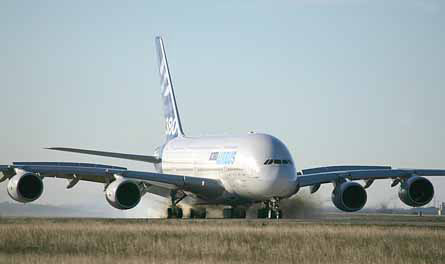Emergency services stand by as rejected take-off demonstration proceeds smoothly
Emergency services stand by as rejected take-off demonstration proceeds smoothly. The Airbus A380 has completed the last major test required for its full certification - the potentially hazardous maximum energy rejected take-off (RTO) demonstration - which Airbus describes as a "non-event".
"The test went exactly as planned," says Airbus chief test pilot Jacques Rosay, who was at the controls of Rolls-Royce Trent 900-powered A380 MSN001 (F-WWOW) alongside vice-president Airbus flight test division Claude Lelaie for the trial at the Istres test airfield in southern France on 4 March. Seven crew were on board, including a flight test engineer representing the European Aviation Safety Agency.
To comply with the certification requirements, the aircraft, which was equipped with 90% worn brakes, completed a 5km (3 miles) taxi during which it made four stops - one to simulate the higher residual idle thrust of the Engine Alliance GP7200-powered aircraft.
RTO tests have resulted in serious damage to aircraft on previous occasions, so Airbus assembled a large team of emergency services with the airfield's fire section bolstered by a unit from Toulouse. "Once the teams were in position, we began the accelerate-stop test on the 5km runway," says Rosay.
With an all-up weight of 575t - 6t above the current 569t maximum take-off weight offered for the A380 passenger version - the aircraft was accelerated down the runway to 166kt (307km/h) before being brought to a halt using spoilers and autobrake on the wheels, with the engines at idle. According to Rosay, Airbus did not have to shut down an engine as "there is no effect on the hydraulics".
|
|---|
The A380's brakes "glowed pink" with heat during the Istres test |
The aircraft was stopped in a distance 20m (66ft) less than that calculated, says Rosay. "We were then required to taxi to the turn pad and wait 5min before any intervention is allowed. The fuse plugs enabled the tyres to begin deflating at around 3min as planned."
Sixteen of the A380-800's 20 main wheels are braked, with the two aft wheels on each body landing gear of the passenger version not having brakes (unlike the freighter variant, where all 20 main wheels are braked due to its increased weights).
Rosay says that by the 5min mark the tyres on all 16 braked wheels had deflated.
"We achieved 120mJ, slightly more than the target of 119mJ. At the end the brakes were pink," says Rosay, adding that everything performed as expected with no fire or damage to the aircraft.
Later in the day, the A380's wheels, brakes and tyres were replaced ahead of the ferry-flight back to Toulouse on 5 March.
Source: Flight International




















